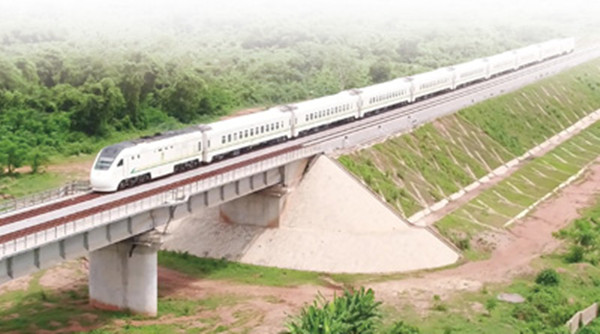Technological Innovation Contributes to Chinese SOEs' Overseas Projects
Technological innovation has been a key part in the overseas projects built by Chinese state-owned enterprises (SOEs), which cover fields like infrastructure construction and energy and resource development.
The innovation-driven projects boost local economic and social development and contribute to high-quality development of the Belt and Road Initiative.
Modern railway boosts economic growth
Stretching from north to south through the vast plain of West Africa is the Lagos-Ibadan railway in Nigeria, the first double-track railway built to modern railway standards in West Africa and the longest of its kind on the continent.
With a total length of about 157 kilometers, the railway links Nigeria's largest city and its southwestern regional commercial center.
Built to modern railway standards, the railway has a designed speed of 150 kilometers per hour, and shortens travel time between the two terminals to two hours.
The railway was built by China Civil Engineering Construction Corporation (CCECC), a subsidiary of China Railway Construction Corporation Limited and carried 500,000 passengers from its debut operation on June 10, 2021 to this January.
The Lagos-Ibadan railway is deemed as a milestone for the country's railway system revitalization and is of great significance to the country's economic growth.
The railway will also bring convenience in daily traveling to local people, improve freight transport efficiency between inland areas and the port, boost quality and accelerate upgrading of the country's industrial and economic development.
As the previous capital city of Nigeria, Lagos had early development and grew a dense population. The resulting various kinds of pipelines, cables and wires created complications and brought challenges in the railway's construction. The already existing narrow-gauge railway that overlapped the new route on the design map added difficulty, and how to renovate the situation and make use of the historical narrow rails became a key issue.
Lu Chengyun, head of the Lagos-Ibadan project, said that considering engineering conditions, and costs, CCECC decided to keep the narrow-gauge railways for the short term. Later, the company and experts in various fields came up with solutions for linkage between the standard and narrow gauge railways and the necessary switches, which realized connection of the two different types of railways.
To give full play of the railway as an artery in Southwest Nigeria, the company planned to expand the railway to the Apapa Quays, the largest port in the country. The 7-kilometer branch railway connected to the Lagos-Ibadan railway makes the freight at the port easy to reach by train, which improves freight transport at the port and relieves congestion caused by trucks entering and exiting the port.
Jiang Yigao, executive director of CCECC's branch in Nigeria, said that the railway plays an indispensable role in promoting the country's export-oriented economic development.
The head of the Nigeria branch of Nigerian Railways Corporation said that the channel between Lagos and Ibadan is the country's most crucial commercial corridor. The Lagos-Ibadan railway has driven development of investment, property and urban development in affected areas.

A train operates on the Lagos-Ibadan railway in Nigeria. [Photo/CCECC]
Ultra-high building technology constructs landmark
In downtown Kuala Lumpur, capital of Malaysia, an eye-catching building tower up. It's the Kuala Lumpur Signature Tower, a landmark of the city.
Integrating various functions like financial affairs, business, shopping and offices, the 452-meter building is one of the tallest in the country.
Built by China Construction Eighth Engineering Division Corp., Ltd, a subsidiary of China State Construction Engineering Corporation, the building was made with 150,000 cubic meters of concrete, 320,000 square meters of templates and 33,000 metric tons of reinforcing steel bars.
The project was completed within only 31 months.
According to Cao Peng, the project manager, technologies such as building information modeling (BIM), a cloud platform, three-dimensional laser scanning, virtual reality and four-dimensional engineering simulation were used during construction, which greatly contributed to the fast construction.
As the tower was built in the city's downtown, impacts on the urban landscape had to be limited. Therefore, all construction elevators were installed inside the core tube of the structure, making the tower the first skyscraper in the country to be built without any engineering equipment installed on the external walls.
China-developed engineering equipment also played a role in the construction, realizing completion of the core tube construction within 20 months.
By the end of 2018, the project was completed and won the Luban Prize, a renowned award in Chinese construction engineering projects.
It's worth mentioning that during construction local investors and contractors often paid visits to the project to gain engineering and management experience, and local college students majoring in civil engineering, project cost and construction safety were recruited as interns at the construction site.
China Construction Eighth Engineering Division Corp., Ltd not only built a landmark for the Malaysian city, but also brought key engineering technologies to the country and contributed to local talent cultivation in skyscraper construction, commented by Chen Xiaoping, editor of Sin Chew Daily.

A view of the Kuala Lumpur Signature Tower in Malaysia [Photo/China State Construction Engineering Corporation]
Intelligent management supports airport rail link
In Sao Paulo, Brazil, the Metro Line 13 trains are busy running between downtown and Guarulhos International Airport. Passengers on the trains are able to enjoy the landscape of the largest city in South America.
The 12.2-kilometer Metro Line 13 went into operation on Feb 3, 2020, and is the first airport rail line in South America. Trains operating on it were manufactured by CRRC Qingdao Sifang Co., Ltd., a subsidiary of CRRC Corporation Limited. With a maximum speed of 100 kilometers per hour, each train can carry as many as 2,538 passengers.
Rail routes in Sao Paulo are complicated with steep gradients and small curvature radii. To meet that challenge, the trains were designed with a shorter 80-meter minimum turning radius and equipped with an advanced traction and braking system, enabling them to start and stop on the slopes.
The trains can resist compression of 150 tons and have an estimated life span of 40 years.
It's worth noting that in addition to Line 13, the trains can also be used on six other metro lines operated by a local company.
Mou Xiaosha, chief designer of CRRC Qingdao Sifang Co., Ltd., said that the trains are equipped with a smart management system that can accurately record real-time passenger numbers and thus supports vehicle dispatching and route operation.
To deal with the high temperature in Sao Paulo, each cabinet is equipped with two high-power air conditioners to improve cooling, and large-sized dynamic electronic maps makes it easier for passengers to read station information.
Luggage carriers are set up above the windows and in front of each carriage, which makes it easier for passengers to carry large baggage.
All the settings go together to provide a comfortable travel experience.
(Executive editor: Niu Yilin)



